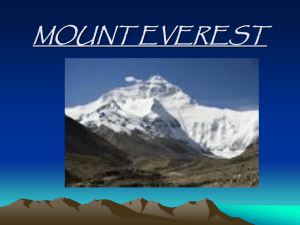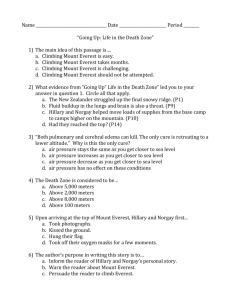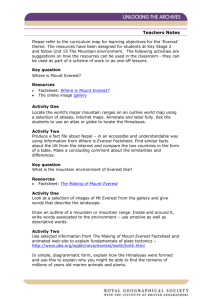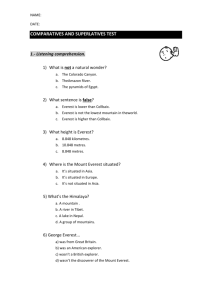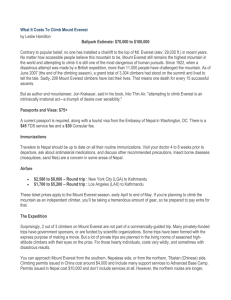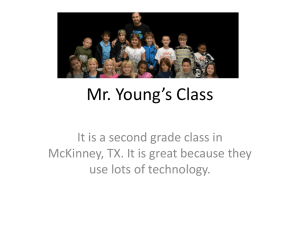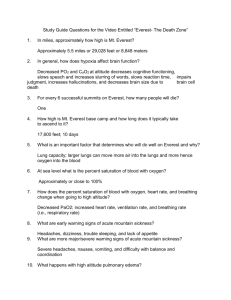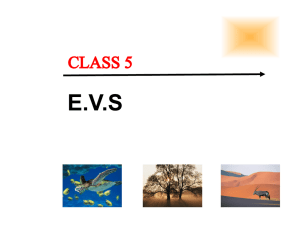Please refer to the curriculum map for learning objectives for the
advertisement
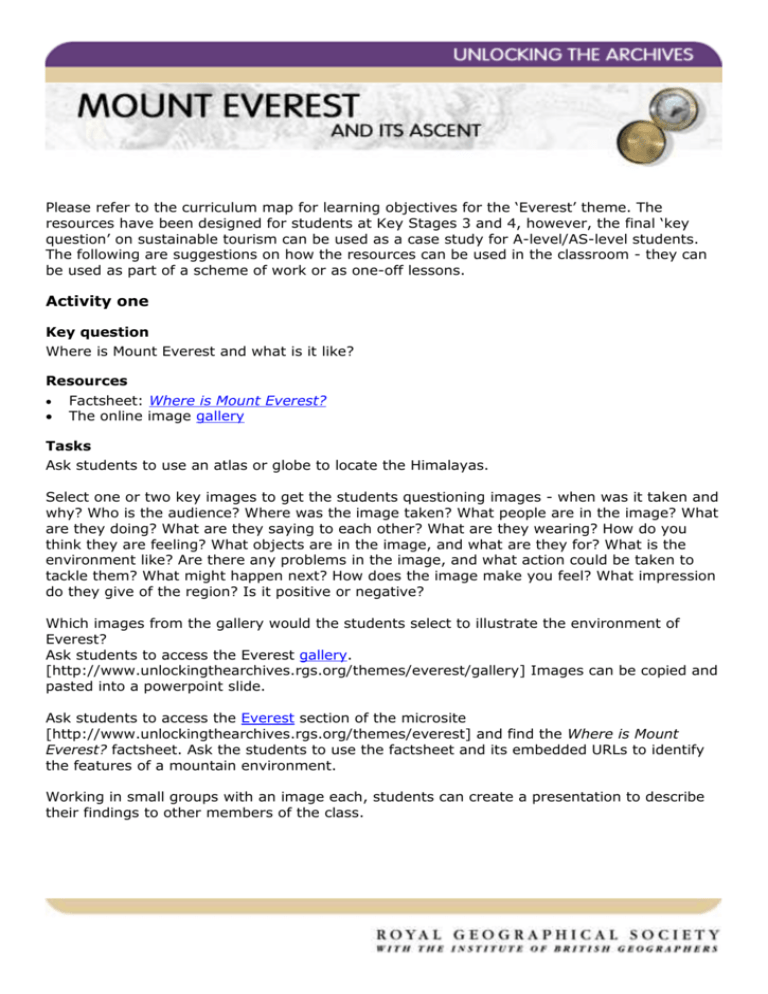
Please refer to the curriculum map for learning objectives for the ‘Everest’ theme. The resources have been designed for students at Key Stages 3 and 4, however, the final ‘key question’ on sustainable tourism can be used as a case study for A-level/AS-level students. The following are suggestions on how the resources can be used in the classroom - they can be used as part of a scheme of work or as one-off lessons. Activity one Key question Where is Mount Everest and what is it like? Resources Factsheet: Where is Mount Everest? The online image gallery Tasks Ask students to use an atlas or globe to locate the Himalayas. Select one or two key images to get the students questioning images - when was it taken and why? Who is the audience? Where was the image taken? What people are in the image? What are they doing? What are they saying to each other? What are they wearing? How do you think they are feeling? What objects are in the image, and what are they for? What is the environment like? Are there any problems in the image, and what action could be taken to tackle them? What might happen next? How does the image make you feel? What impression do they give of the region? Is it positive or negative? Which images from the gallery would the students select to illustrate the environment of Everest? Ask students to access the Everest gallery. [http://www.unlockingthearchives.rgs.org/themes/everest/gallery] Images can be copied and pasted into a powerpoint slide. Ask students to access the Everest section of the microsite [http://www.unlockingthearchives.rgs.org/themes/everest] and find the Where is Mount Everest? factsheet. Ask the students to use the factsheet and its embedded URLs to identify the features of a mountain environment. Working in small groups with an image each, students can create a presentation to describe their findings to other members of the class. Activity two Key question How was Mount Everest formed? Resources Factsheet: The Making of Mount Everest Activity sheet: The Death Zone Tasks The factsheet can be used to give students an understanding of how Everest was formed. A useful animated version [http://www.pbs.org/wgbh/nova/everest/earth/] is available online. Ask the students to study the image of Everest on the factsheet or download an enlarged version from the gallery. Ask them for words to describe the landscape. Brainstorm the difference between weather and climate. What are the effects of high altitude? Give students a copy of the Death Zone resource. Ask them to think about the implications of the effects of high altitude on the weather and climate, on the landscape of the region, and the people who might visit. Students could use internet resources to find the actual weather forecast for the Himalayas. Students can go on to consider glacial processes, the implications of crevasses, jagged rocks, rock falls, and avalanches. Activity three Key question How was Mount Everest measured? Resources Factsheet: Measuring Mount Everest The online image gallery Tasks Use the first page of the online image gallery to illustrate how the mountain was mapped and surveyed. Explain that it was part of a much larger survey on the mapping of India and that the people involved included British surveyors, Indians and Tibetans. (Some historical context is also provided by the factsheet.) Students should make their own selection of images and text to highlight the challenges faced in measuring Everest, the people it involved, and how it got its name. The images can be downloaded and transferred to presentation software for the creation of slides. Students can also consider how the heights of mountains are measured today and the use of GPS. Activity four Key question Who lives in the Everest region? Resources Factsheet: People of the Khumbu Region Activity sheet: Views of Everest (exploring different maps and text on Everest) Tasks Ask students to consider how people’s lifestyles have changed since the first successful ascent in 1953. What opportunities has tourism brought to the people? Has it had an effect on the cultural life of the people? Ask students to work through the activities in Views of Everest to identify the different perceptions of Everest by the local people and the first expedition members. Activity five Key question Who first reached the top of Mount Everest? Resources Factsheet: Reaching the Top Activity sheet: Climbing Mount Everest (role-play cards) Tasks Tell the story of the 1953 ascent to the top using the background information and the image gallery. Emphasise the roles and teamwork involved in a successful expedition. The images can be printed out for the students or projected onto a whiteboard. Tell the students they will be working in groups of six to plan their own expedition. Give the students the role play cards. There are six roles with different responsibilities: leader, lead Sherpa, doctor, reporter/photographer, two climbers. Brainstorm the risks that teams face in planning an expedition, including climate, altitude, health and safety considerations, and so on. What precautions can the students take to minimise the risks? The students who have the same roles can work together to do their research; give each student the website links page (last page of the activity sheet). They should also use the image gallery and download the video clips that show some of the early expeditions, particularly Food and Drink and Climbing and Breathing. The factsheet, Who Lives in the Everest Region?, also gives information about the working conditions of porters. Allow the students sufficient time to plan their expedition and decide how they will present their plan to the rest of the class. The rest of the class can assess the merits of each plan: Has the group undertaken sufficient research? Have all possible risks been considered? Should they be given funding to undertake their expedition? Activity six Key question Who works towards a sustainable future? Resources Factsheet: Tourism in the Everest Region Activity sheet: Managing the Mount Everest Region (role-play cards) Tasks Students should consider the economic, social and environmental impact of tourism in the region. Ask students to draw up a table of the positive and negative effects of tourism on the region using the information under each of the headings; environment, economic, social and cultural, found in the factsheet. Work through the activities in Managing the Everest Region to explore the different views towards managing the environment.
